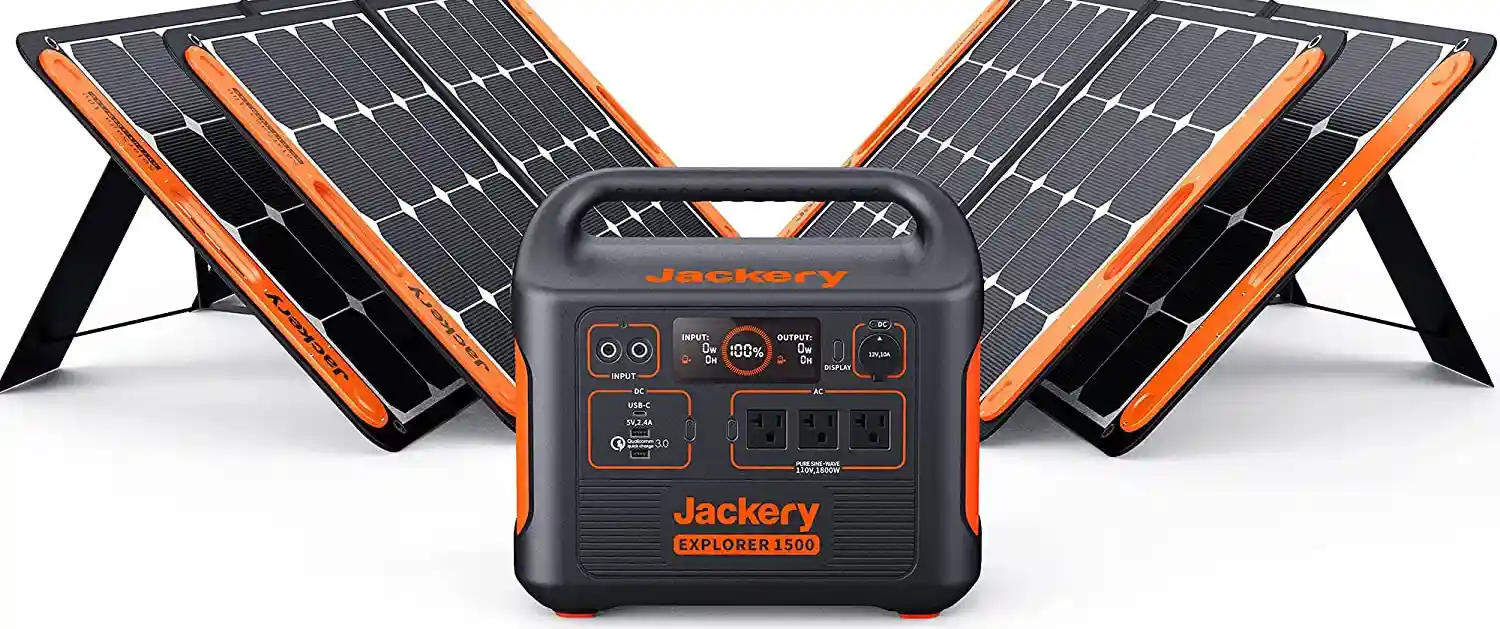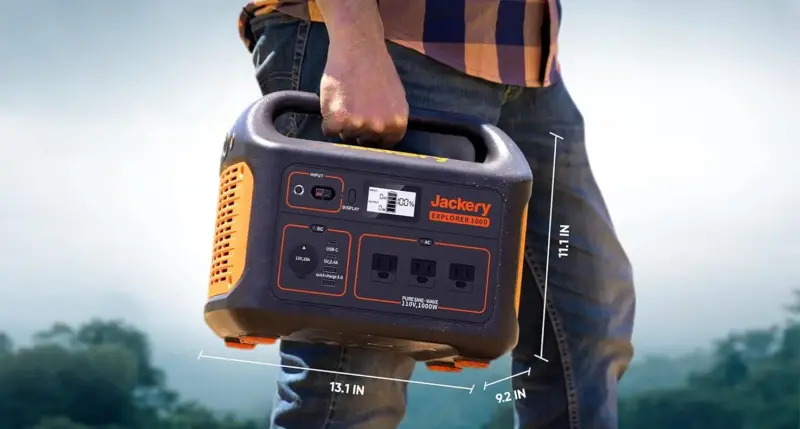Jackery vs Generator (Differences)

The Jackery versus a traditional generator (e.g., gasoline-powered). Given my experience with alternative energy systems, I would like to highlight a big difference between them. While there are pros and cons, there’s one particular difference between an ordinary (gas) generator and something like a Jackery Portable Power Station that I would like to mention. Or any similar energy storage device/brand that uses battery technology for energy storage. Sometimes, they’re called solar generators (because one typical charging method is with solar panels).
Given the popular brand, let’s discuss Jackery versus a gas generator.
A fuel-powered generator (typically gasoline). Where is the energy stored? It’s in the gasoline itself. The gas. That’s the energy source. When the gas runs out, you pour more into the tank.
A Jackery (or equivalent) portable power station. Where’s the energy stored? It’s in the battery. How does it get there? Either by plugging it into a standard AC outlet or using solar panels. Vehicle accessory outlets can slow-charge these, too.
But here’s what I find particularly interesting when comparing the operation of a Jackery vs a generator…
Differences Between Jackery vs Gasoline Generator
Let’s say they are both 3,000-watt generators. Yes, Jackery makes a 3,000-watt solar generator…
Popular Models are linked below
As you know, the combustion engine within a gasoline-powered generator runs all the time. It delivers 3,000 watts (in this example) available for consumption. It’s constantly using fuel (gas) to make that power/energy available, regardless of what’s plugged into it and whether or not the load demands all of it.
Jackery Energy Efficiency vs Generator
If the plugged-in load only uses 200 watts, the gas-powered generator uses way more fuel than needed (because there are about 2,800 watts not being used, and the engine is always running). Okay, a caveat… Some generators will automatically throttle down (slow down) when there is a lower power demand. My Yamahas do that. However, it’s still always running, and there’s still lots of inefficiency compared to what I will say next.
The Jackery generator, for instance, is a unique power solution. Unlike a typical gas generator, when the Jackery is ON, it consumes no fuel or energy (hardly any) until a load is connected. For example, when a device requiring 200 watts is plugged in, the Jackery generator supplies precisely that amount, ensuring no wasted energy.
When you shut off that load, the Jackery generator consumption drops to nearly zero. Silently waiting… So it’s efficient that way, compared to a gasoline-powered generator that keeps on guzzling gas, even with no load.
I say “nearly zero” energy when the Jackery waits for a load. Some electronics run when it’s turned ON, consuming minimal power, even without a load connection. Over some time, this will slowly drain the battery (just being clear on this).
Okay, there are some advantages to a gasoline generator. Most gas-powered generators can provide higher power than a typical portable battery power station. The gas generator will keep running and delivering power if you have fuel. It doesn’t need to be charged back up. A battery-powered generator (like the Jackery) will require recharging after the stored energy is consumed (or during).
Example Using Jackery For Chest Freezer During Power Outage
An ordinary gasoline generator would work for this. However…
I have several chest freezers, and I know their power demand. I’ve measured the load and consumption. It’s less than you might think for a typical chest freezer (because most chest freezers are efficient and well-insulated).
Tip: The best meter to measure power consumption over time!
I may earn commission (no extra cost) if purchased.
Thank you

A power station like the Jackery would work well to keep a chest freezer running during a power outage. The storage capacity of the internal battery system would determine how long it would run.
Recent measurements using my power station to operate my chest freezers resulted in an average of about 1,200 watts of consumption for each mid-size chest freezer in 24 hours (1.2 kWh a day).
Bonus: If you have solar panels to keep charged, you could power this indefinitely. Each manufacturer offers solar panels for its power stations (although you can do it yourself, too).
Jackery Power Station Advantage
The Jackery has the advantage in this example. Not only is it silent and can be operated safely indoors, but it is also highly efficient compared to a gas generator.
It’s a simple but notable concept. A gas generator will consume fuel even with no load on it. A Jackery (or equivalent) power station will drop energy consumption to almost zero if it’s turned ‘ON’) when there’s no load. That’s highly efficient vs a gas generator!
Like their competitors, there are various models with various energy storage capacities depending on your needs and applications. The more capacity, the more it will cost. They will also get larger and heavier.
The Jackery brand, founded in California in 2012, is number one worldwide for retail sales volume.
The Jackery Explorer 1000 portable power station is among their most popular models.

Notable features of the very popular Jackery 1000 include 1,500 Watts of power, 1kWh capacity, 3 AC outlets, 1 USB-A, 1 USB-A quick charge 3.0, 2 USB-C PD, 1 car outlet, MPPT charge controller, optional solar panels, pure sine wave inverter, pass-through charging, and comfortable carry handle. It is very portable and maneuverable, lightweight, and, of course, quiet. It will likely power ~ 90% of home appliances and is great for outdoor adventures. There are so many other uses…
View more specs and details of the popular Jackery models on their primary storefront on Amazon:
Advantages of the Jackery (or other power generators)

Noise
The Jackery and other similar power stations are 100% silent. A gas generator is often quite noisy.
Emissions
The Jackery is safe to operate indoors and produces no emissions, so it is very convenient to plug in devices. A gasoline generator must emit exhaust and be outside for safety and fumes, and a power cord should be brought inside the home.
Recharging and Fuel
The Jackery can be recharged using solar panels, wall outlets, or car chargers (check the model). This versatility in charging methods makes it a reliable choice for off-grid use and emergencies. Gas-powered generators require a constant supply of fuel, which can be a limitation in remote areas or during extended power outages.
Power Output and Capacity
Jackery and other solar power generators offer capacities from a few hundred watts to thousands of watts. There are many choices. Gas-powered generators typically have high power outputs designed to run continuously.
You might say that the Jackery (or similar ‘solar generators’) provide near “endless” power, provided you have the solar panel option.
Portability and Size
The Jackery and competitor power generators are smaller and lighter in weight than a typical gas generator. They are easily handled and portable, making them popular for camping or RV camping. Gas-powered generators are bulkier, heavier, and less convenient in terms ofportability.
Use Cases
Solar power generators are ideal for camping, RV trips, marine adventures, and small-scale home backup power (although larger-scale models are becoming available). They are also suitable for emergency preparedness and short-term power needs.
Gas-powered generators are better suited for more extensive power needs, such as powering entire homes or running heavy-duty equipment.
Portable Power Stations – Watt Hours Explained… (Wh)
‘Kill A Watt Meter’ — How to Measure Power Consumption (kWh)
How To Keep Chest Freezer or Fridge Running During Power Outage
Among the highest priorities for survival is safe drinking water.
AlexaPure Pro Gravity-Powered Water Filtration
Tested against NSF/ANSI 53, NSF/ANSI 42

